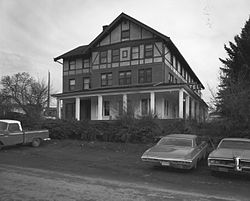
Lincoln County is a county located in the U.S. state of Montana. As of the 2020 census, the population was 19,677. Its county seat is Libby. The county was founded in 1909 and named for President Abraham Lincoln. The county lies on Montana's north border and thus shares the US-Canadian border with the Canadian province of British Columbia.

Kootenai County is located in the U.S. state of Idaho. In 2020, the United States Census Bureau estimated the county's population at 171,362, making it the third-most populous county in Idaho and by far the largest in North Idaho, the county accounting for 45.4% of the region's total population. The county seat and largest city is Coeur d'Alene. The county was established in 1864 and named after the Kootenai tribe.
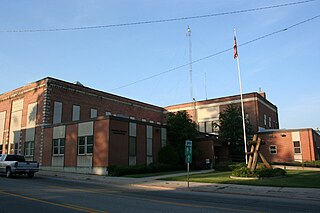
Bonner County is a county in the northern part of the U.S. state of Idaho. As of the 2020 census, the population was 47,110. The county seat and largest city is Sandpoint. Partitioned from Kootenai County and established in 1907, it was named for Edwin L. Bonner, a ferry operator.

The Kootenay River or Kootenai River is a major river of the Northwest Plateau in southeastern British Columbia, Canada, and northern Montana and Idaho in the United States. It is one of the uppermost major tributaries of the Columbia River, the largest North American river that empties into the Pacific Ocean. The Kootenay River runs 781 kilometres (485 mi) from its headwaters in the Kootenay Ranges of the Canadian Rockies, flowing from British Columbia's East Kootenay region into northwestern Montana, then west into the northernmost Idaho Panhandle and returning to British Columbia in the West Kootenay region, where it joins the Columbia at Castlegar.
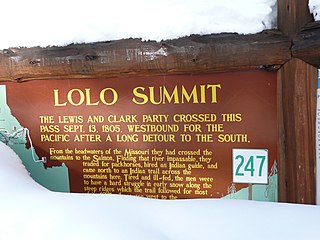
Lolo Pass, elevation 5,233 feet (1,595 m), is a mountain pass in the western United States, in the Bitterroot Range of the northern Rocky Mountains. It is on the border between the states of Montana and Idaho, approximately forty miles (65 km) west-southwest of Missoula, Montana.
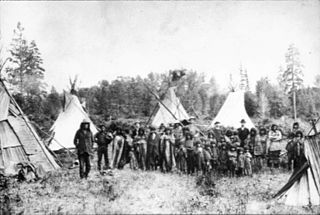
The Kutenai, also known as the Ktunaxa, Ksanka, Kootenay and Kootenai, are an indigenous people of Canada and the United States. Kutenai bands live in southeastern British Columbia, northern Idaho, and western Montana. The Kutenai language is a language isolate, thus unrelated to the languages of neighboring peoples or any other known language.

This is a directory of properties and districts included among the National Register of Historic Places listings in Idaho. There are approximately 1,000 sites in Idaho listed on the National Register. Each of the state's 44 counties has at least one listing on the National Register.
Roosevelt School may refer to:

Coeur d'Alene's Old Mission State Park is heritage-oriented in the western United States in northern Idaho, preserving the Mission of the Sacred Heart, or Cataldo Mission, a national historic landmark. The park contains the church itself, the parish house, and the surrounding property. Built in 1850–1853, Mission of the Sacred Heart is the oldest standing building in Idaho.[1] It was designated a National Historic Landmark in 1961,[2] and put on the National Register of Historic Places in 1966.[3]

The Saint Joe River is a 140-mile (225 km) long tributary of Coeur d'Alene Lake in northern Idaho. Beginning at an elevation of 6,487 feet (1,977 m) in the Northern Bitterroot Range of eastern Shoshone County, it flows generally west through the Saint Joe River Valley and the communities of Avery and Calder. Past Calder, it flows into Benewah County and through the town of St. Maries, where it receives its largest tributary, the Saint Maries River. It then turns northwest, passing through Heyburn State Park before reaching its mouth just north of the Kootenai County line. Much of the river's route through Heyburn State Park is partially flooded due to raised water levels from the Washington Water Power dam at Post Falls on the Spokane River below Coeur d'Alene Lake. With a mouth elevation of 2,129 feet (649 m), it is claimed to be the highest navigable river in the world. Multiple rivers in Canada are both higher and navigable, including the Babine, and Middle Rivers.

This is a list of the National Register of Historic Places listings in Kootenai County, Idaho.
Medimont is an unincorporated community in Kootenai County, Idaho, United States. Medimont is located on the north shore of Cave Lake, 8.5 miles (13.7 km) east-northeast of Harrison. Medimont has a post office with ZIP code 83842.
Tourtellotte & Hummel was an American architectural firm from Boise, Idaho and Portland, Oregon.
Clarence Ferris White was a prolific architect in the Pacific Northwest. He designed more than 1,100 buildings, including 63 schools, in the State of Washington. His largest project was the design of the company town of Potlatch, Idaho in 1905. Several of his works are listed on the United States National Register of Historic Places.
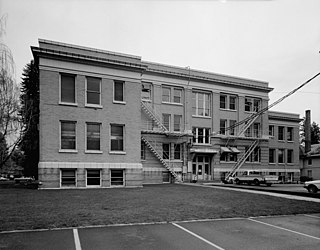
The Kootenai County Courthouse, located at 501 Government Way in Coeur d'Alene, is the county courthouse serving Kootenai County, Idaho. The courthouse was built in 1925–26. Spokane architect Julius A. Zittle designed the Georgian Revival building. A portico at the entrance features an entablature, frieze, and balcony supported by two Doric columns. The second-floor front windows are arched and have terra cotta ornamentation; brick pilasters separate the windows. The building is topped by a cornice and a brick parapet; a decorative Idaho state seal is located on the parapet above the entrance.

The Bayview School II in Bayview in Kootenai County, Idaho was a historic school built in 1911. It was listed on the National Register of Historic Places in 1985.

The Coeur d'Alene City Hall is a historic building in Coeur d'Alene, Idaho. It was built in 1908, and designed in the Renaissance Revival style by architect George Williams. It served as the de facto courthouse until the construction of the Kootenai County Courthouse in 1926, and it later housed the offices of city officials, police officers and firefighters. It has been listed on the National Register of Historic Places since August 3, 1979.

The Clark House is a historic house in Clarksville, Idaho. It was built in 1912 as a summer residence for F. Lewis Clark, a mining millionaire who disappeared in Santa Barbara in 1914 and was believed to have committed suicide. Clark's servants lived in the wings. The house was designed in the American colonial style and has been attributed to architect Kirtland Cutter; however, blueprints discovered in Boise, ID show that the actual architect was George Canning Wales of Boston. It has been listed on the National Register of Historic Places since December 12, 1978.
The Methodist Episcopal Church in Emmett, Idaho, was built in 1906. It was listed on the National Register of Historic Places in 1980.
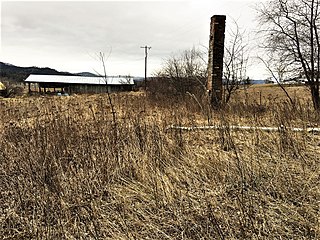
The Cave Lake School, in Kootenai County, Idaho near Medimont, Idaho, was built in 1913. It was listed on the National Register of Historic Places in 1985.
